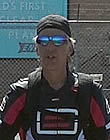|
|
This topic comprises 2 pages: 1 2
|
|
Author
|
Topic: USL XTA-1 Crossover
|
|
|
Tony Bandiera Jr
Film God

Posts: 3067
From: Moreland Idaho
Registered: Apr 2004
|
 posted 03-10-2010 01:15 PM
posted 03-10-2010 01:15 PM




Tom:
I will provide the answers best that I can, but I cannot remember for sure the right answer to the first one, but here goes:
What outputs for each amp correspond to the hf and lf?
I think it was Ch 1 LF and Ch 2 HF Or wait for Clint to chime in.
Oh yeah, VERY IMPORTANT: Don't forget to set the little DIP switches on the amp properly or the crossover WON'T work, you could damage the crossover and the speakers!!
Do you already have the extra wire to the stage for each speaker? You will need a pair for both HF and LF.
Are the gain controls on the amp used for the hf and lf output?
Yes. You will use them as described below.
Or is the hf gain control on the XTA-1 used for hf output?
Only if needed to boost or cut the HF output if the amp's gain controls don't give adequate range in the HF. I have traditionally set this to mid-point and left it alone.
Also, when setting sound pressure levels, how do you match the hf and lf of each channel for 85dbc?
You don't adjust them of 85dbc each, per say, but for the flattest response BEFORE any EQ is done, using an RTA. You CAN NOT set this or do a proper B chain without using an RTA!!!
Basically, what is the proper method for performing a B-chain alignment when bi-amping? ![[Big Grin]](biggrin.gif)
After properly connecting all of the speakers and making sure they are all in phase (remember JBL's LF bins are electrically out of phase with the HF in many cases), you will set up the mics and multiplexer for your RTA in the room, set ALL EQ on your processor to FLAT, then using pink noise and one channel at a time, set the HF and LF levels on the amps to get the most even (flattest) response possible before applying any EQ.
I'm not going to go over the details of a proper room EQ from here, it would take far too long to explain properly. It is something best done by a technician who knows how to do it and has a good ear, as the best job is done by balancing measured results with adjustments made by ear.
Your best bet, to preserve your sanity, equipment and possibly your customer base, is to hire a tech to do this for you. It will cost nothing compared to the potential harm of not doing it right.
| IP: Logged
|
|
|
|
|
|
|
|
|
|
|
|
|
|
|
|
|
|
|
|
|
|
|
|
|
|
|
|
|
|
All times are Central (GMT -6:00)
|
This topic comprises 2 pages: 1 2
|
Powered by Infopop Corporation
UBB.classicTM
6.3.1.2
The Film-Tech Forums are designed for various members related to the cinema industry to express their opinions, viewpoints and testimonials on various products, services and events based upon speculation, personal knowledge and factual information through use, therefore all views represented here allow no liability upon the publishers of this web site and the owners of said views assume no liability for any ill will resulting from these postings. The posts made here are for educational as well as entertainment purposes and as such anyone viewing this portion of the website must accept these views as statements of the author of that opinion
and agrees to release the authors from any and all liability.
|

 Home
Home
 Products
Products
 Store
Store
 Forum
Forum
 Warehouse
Warehouse
 Contact Us
Contact Us




 Printer-friendly view of this topic
Printer-friendly view of this topic





![[Big Grin]](biggrin.gif)







